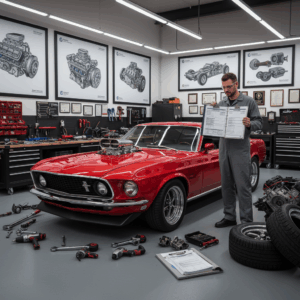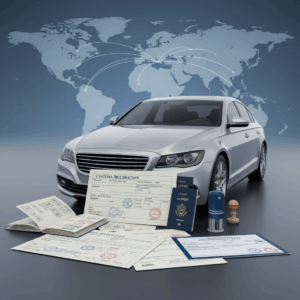Overview of International Car Regulations
International car regulations aim to establish uniform technical and safety standards to facilitate cross-border trade and reduce non-tariff barriers. These rules are crucial for the global automotive market’s smooth functioning.
By harmonizing vehicle requirements, these regulations help ensure vehicles meet consistent quality and safety benchmarks worldwide, benefiting manufacturers and consumers alike.
Purpose and Goals of Regulations
The primary goal is to create standardized vehicle approval processes that enable products to move freely between countries without unnecessary complications. This increases efficiency in the global supply chain.
These regulations also strive to enhance road safety and environmental protection, ensuring vehicles adhere to strict limits on emissions and performance across markets.
Ultimately, international regulations seek to balance industry innovation with public safety and sustainability concerns to foster a competitive yet secure automotive sector.
Role of the World Forum for Harmonization
The World Forum for Harmonization of Vehicle Regulations serves as a global platform for developing unified rules that member countries can adopt to streamline vehicle approvals.
It works to reduce disparities in technical requirements, allowing manufacturers to comply with a single set of standards rather than multiple, conflicting ones.
This forum plays a vital role in promoting international collaboration and supporting trade by facilitating consensus on vehicle safety, environmental, and performance criteria.
Regional Regulatory Frameworks and Trade Barriers
The vehicle approval process in different regions shapes the automotive industry’s market dynamics. Regulatory frameworks vary widely, impacting trade and market access for manufacturers.
Trade barriers such as tariffs and differing standards complicate the global exchange of vehicles, creating challenges for automakers trying to enter multiple markets efficiently.
Understanding these regional frameworks is essential to navigating the complexities of international vehicle sales and to achieving smoother global integration.
European Union Vehicle Approval Standards
The European Union has implemented Regulation (EU) 2018/858 to harmonize vehicle approval processes across member states, ensuring consistent safety and environmental standards.
This regulation facilitates the free movement of vehicles within the EU market by reducing duplication of testing and certification requirements among countries.
By streamlining approvals, the EU aims to foster a competitive market and support innovation while maintaining high public safety and emissions standards.
Regulatory Differences Between Europe and Japan
Europe and Japan maintain distinct vehicle regulations, especially regarding emissions, safety, and homologation testing methods, which affect cross-border vehicle trade.
These differences create non-tariff trade barriers, as manufacturers must adapt vehicles to meet separate requirements, increasing costs and time to market.
Efforts to align standards remain ongoing but challenges persist due to differing regulatory priorities and market conditions in each region.
Impact of Tariffs on Global Sales
Tariffs, such as the 10% import duty in Europe on non-originating vehicles, significantly influence the pricing and competitiveness of cars in global markets.
These tariffs can discourage importers and affect manufacturers’ strategic decisions regarding production location and market focus.
Consequently, tariffs remain a major consideration in global sales strategies, often leading to efforts to negotiate trade agreements to reduce such financial barriers.
Trade Agreements Influencing Car Regulations
Trade agreements play a crucial role in shaping car regulations and easing market access for manufacturers. They often aim to reduce tariffs and harmonize technical standards between countries.
Such agreements help foster competitive markets by eliminating trade barriers while encouraging compliance with shared regulatory requirements across borders.
EU-UK Trade Agreement on Automotive Sector
The EU-UK Trade Agreement includes provisions to eliminate tariffs on cars and automotive components, promoting smoother trade post-Brexit. This helps preserve competitiveness in both markets.
It also emphasizes rules of origin to qualify for tariff-free access, encouraging manufacturers to source parts from the EU or UK, which supports regional supply chains.
Moreover, the agreement facilitates cooperation on regulatory standards, aiming to minimize divergence that could create technical barriers to trade over time.
Promotion of Local Production and Competition
Trade agreements often incentivize local production by setting content requirements for vehicles and components, such as batteries for electric cars, bolstering domestic industries.
This strategy promotes competition by encouraging investment in manufacturing facilities and supply chains within member countries or regions.
By supporting local production, these agreements help create jobs and economic growth while ensuring vehicles meet shared regulatory standards for safety and emissions.
Challenges and Future Outlook
Despite efforts toward harmonization, significant obstacles remain due to regulatory differences across countries, complicating global automotive trade. These inconsistencies increase costs and delay market entry.
Addressing these challenges is crucial to unlocking a more efficient, interconnected global car market that benefits manufacturers, consumers, and economies worldwide.
Obstacles Created by Regulatory Differences
Varying safety, emissions, and testing standards force automakers to modify vehicles for each region, resulting in higher production costs and operational complexity.
These regulatory divergences act as non-tariff barriers, reducing competitiveness and slowing down the integration of car markets internationally.
Manufacturers must navigate overlapping approval processes, which impede innovation and limit access to some key global markets.
Potential for a More Integrated Global Market
Greater alignment of vehicle regulations could reduce redundancies, allowing manufacturers to sell cars worldwide with fewer modifications and lower costs.
International collaboration and agreements hold promise for establishing uniform standards that enhance trade efficiency and consumer safety globally.
Such integration would foster innovation, encourage investment, and create a more dynamic automotive industry capable of meeting evolving demands.
Strategic Importance of Harmonization
Global regulatory convergence could drive sustainability by promoting uniform environmental standards and advanced safety technologies.
Harmonization also simplifies supply chains, helping automakers respond faster to market changes and consumer preferences on a worldwide scale.







